Princeton Historic District (Princeton, New Jersey)
The Princeton Historic District is a 370-acre (150 ha) historic district located in Princeton, New Jersey that was listed on the U.S. National Register of Historic Places in 1975. It stretches from Marquand Park in the west to the Eating Clubs in the East, from the Princeton Cemetery in the north to the Graduate College in the south. The district encompasses the core parts of the campuses of the Princeton Theological Seminary and Princeton University. It also includes the business district centered on Nassau Street and many historic homes, both mansions in the western section and more humble dwellings in the Witherspoon/Jackson neighborhood. Notable churches within the district include Nassau Presbyterian Church, Trinity Episcopal, Nassau Christian Center, and the Princeton University Chapel. The district is home to seven of Princeton's nine, and New Jersey's fifty-eight, National Historic Landmarks, the largest concentration of such sites in the state.
Princeton Historic District | |
 Historic residential architecture in the district | |
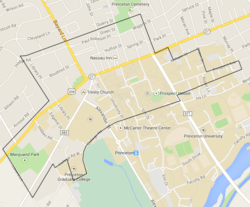 Map of the Princeton Historic District | |
| Location | Irregular pattern between Lytle St. and Haslet Ave. from Lovers Lane to Olden Sts., Princeton, New Jersey |
|---|---|
| Coordinates | 40°20′55.4″N 74°39′33.6″W |
| Area | 370 acres (150 ha) |
| Built | 1756 (Nassau Hall) |
| Architect | Multiple |
| Architectural style | Mid 19th Century Revival, Late Victorian, Colonial |
| NRHP reference No. | 75001143 |
| NJRHP No. | 1741[1] |
| Significant dates | |
| Added to NRHP | June 27, 1975 |
| Designated NJRHP | October 29, 1973 |
Significance
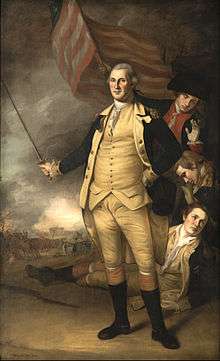
Princeton, and the world-renowned University to which it is home, has played a significant role in 300 years of American history. Not only does the town have a strong architectural heritage, it has also made notable contributions to the world of politics, religion, science, and literature.
Princeton's first settlers came in the 1690s, with Quakers settling along the Stony Brook, and the Kingston Mill being built along the Millstone River. The town itself grew up in the early 18th century along an old Indian trail which became Nassau Street. The College of New Jersey, which became Princeton University in 1896, was founded in 1746 and moved to Princeton ten years later on the completion of Nassau Hall. The town sent two residents to sign the Declaration of Independence, Richard Stockton and John Witherspoon. A third former resident, Joseph Hewes, whose house, Maybury Hill, is a national historic landmark in Princeton that lies outside the historic district, also was a signer. The town was occupied by the British during the American Revolution, using Bainbridge House as their headquarters. After his famous crossing of the Delaware and victory at the Battle of Trenton, George Washington led the Continental Army to victory at the Battle of Princeton on January 3, 1777. Nassau Hall itself served as the capital of the United States in the summer of 1783 and George Washington received the nation's thanks there.
Princeton was home to four presidents, James Madison and Woodrow Wilson as students, the later also as university president, Grover Cleveland in the years after he left the White House, and John F. Kennedy during his freshman year, before his transfer to Harvard. Aaron Burr, Jr. was a student here before being Vice-President of the United States and is buried in the Princeton Cemetery at the feet of his more highly esteemed father, Aaron Burr, Sr., and theologian grandfather, Jonathan Edwards. Many architects from Benjamin Latrobe and Ralph Adams Cram to I.M. Pei and Frank Gehry have left their mark on the town. As home to the oldest Presbyterian Theological Seminary, Princeton has been host to many important theologians from Archibald Alexander and Samuel Miller to Charles Hodge and B.B. Warfield. Joseph Henry brought Princeton first to prominence as a center of science, a legacy that led Albert Einstein to make Princeton's Institute for Advanced Study his home after he fled Germany in 1933. Princeton has also been home to writers as varied as Thomas Mann, Upton Sinclair, F. Scott Fitzgerald, and Toni Morrison.[2]
Contributing properties
National Historic Landmarks
| [3] | Landmark name | Image | Date designated[4] | Location | Built | Description |
|---|---|---|---|---|---|---|
| 1 | Nassau Hall | Nassau Hall |
October 9, 1960 (#66000465) |
91 Nassau St 40°20′55″N 74°39′34″W |
1756 | The oldest building at Princeton University and the largest in New Jersey when it was built in 1756. It served as the home of the American government from July to October 1783. |
| 2 | Morven | 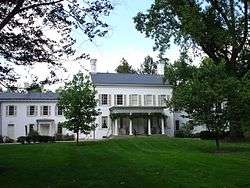 Morven |
July 17, 1971 (#71000503) |
55 Stockton 40°20′51″N 74°40′01″W |
1750s | Built in 1754 by Richard Stockton (1730-1781), a signer of the Declaration of Independence. It served as the New Jersey Governors mansion from 1945 until 1982 and is now a museum. |
| 3 | Maclean House | 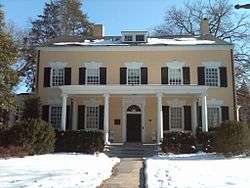 Maclean House |
July 17, 1971 (#71000504) |
73 Nassau St 40°20′57″N 74°39′37″W |
1756 | John Witherspoon lived in this home for the President of the College of New Jersey (later Princeton University) between 1768 and 1779. During this time he also served as a delegate to the Continental Congress and signed the Declaration of Independence. |
| 4 | Joseph Henry House | 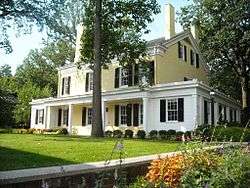 Joseph Henry House |
January 12, 1965 (#66000464) |
95 Nassau St 40°20′58″N 74°39′32″W |
1838 | Home of Joseph Henry, whose scientific research on electromagnetic self-inductance led to the electrical telegraph. He was also the first Secretary of the Smithsonian Institution. |
| 5 | Prospect | Prospect |
February 4, 1985 (#85002434) |
McCosh Walk 40°20′50″N 74°39′24″W |
1851 | A fine example of John Notman's architecture. It formerly served as the official home of the President of Princeton University, and is now the faculty club. Woodrow Wilson lived here from 1902 to 1910, prior to entering politics. |
| 6 | Westland Mansion | 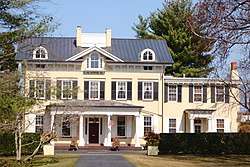 Westland Mansion |
June 23, 1965 (#66000463) |
15 Hodge Road 40°21′05″N 74°40′04″W |
mid-19th century | Mid-19th century mansion built by Robert F. Stockton and later home of Grover Cleveland after he left the White House. |
| 7 | Albert Einstein House | Albert Einstein House |
January 7, 1976 (#76002297) |
112 Mercer 40°20′36″N 74°40′01″W |
Before 1876 | The home of Albert Einstein after his flight from Germany in 1933 until his death in 1955. |
Independently listed on the National Register of Historic Places
| [3] | Name on the Register | Image | Date listed[4] | Location | Built | Description |
|---|---|---|---|---|---|---|
| 8 | University Cottage Club | University Cottage Club |
November 19, 1999 (#99001315) |
51 Prospect 40°20′54″N 74°39′06″W |
1906 | One of Princeton's historic eating clubs, designed by McKim, Mead & White |
Other significant contributing properties
| [3] | Name on the Register | Image | Date listed[4] | Location | Built | Description |
|---|---|---|---|---|---|---|
| 9 | The Barracks | .jpg) The Barracks |
June 27, 1975 (#75001143) |
32 Edghill St 40°20′42″N 74°40′05″W |
ca. 1686 | Built late 17th century, considered to be the oldest house still standing in Princeton. Built by the grandfather of Richard Stockton, a signer of the Declaration of Independence. The name derives from its presumed use as a barracks in the French and Indian War or American Revolution.[5] |
| 10 | Princeton Cemetery |  Princeton Cemetery |
June 27, 1975 (#75001143) |
29 Greenview Av 40°21′14″N 74°39′35″W |
1757 | Burial place of many prominent figures including Jonathan Edwards, Aaron Burr, Grover Cleveland, Paul Tulane, and Kurt Gödel among many others. |
| 11 | Bainbridge House | .jpg) Bainbridge House |
June 27, 1975 (#75001143) |
158 Nassau St 40°21′02″N 74°39′27″W |
1766 | Built by Job Stockton of brickwork with wooden keystone lintels to a central hall plan, it retains much of its original woodwork and corner fireplaces. It was the birthplace of Commodore William Bainbridge and served as the headquarters of the British in 1776 before the Battle of Princeton. It has long served as the museum of the Princeton Historical Society. |
| 12 | Peacock Inn |  Peacock Inn |
June 27, 1975 (#75001143) |
20 Bayard Lane 40°20′57″N 74°39′56″W |
before 1779 | 18th century home of Jonathan Deare, moved to Bayard Lane in 1875 by William Libbey.[6] Since 1911 an inn and restaurant, one of the finest in the state.[7] |
| 13 | Beatty House |  Beatty House |
June 27, 1975 (#75001143) |
19 Vandeventer 40°21′06″N 74°39′27″W |
ca. 1780 | Built by Jacob Hyer, by whose name it is sometimes known, the house was purchased by Erkuries Beatty in 1816. The Marquis de Lafayette is known to have stayed here July 15, 1825. It was originally located on Nassau Street opposite Bainbridge House and was moved to its current location by James Vandeventer in 1875.[8] |
| 14 | Stanhope Hall | Stanhope Hall |
June 27, 1975 (#75001143) |
Elm Drive 40°20′55″N 74°39′36″W |
1803 | The third building of Princeton University's campus, designed by Benjamin Henry Latrobe and originally home to the library, study halls, and literary societies. Later known as Geological Hall, in 1915 it was named in honor of Samuel Stanhope Smith, president of the university at the time of its construction. |
| 15 | Nassau Club | .jpg) Nassau Club |
June 27, 1975 (#75001143) |
6 Mercer St 40°20′53″N 74°39′48″W |
1813-14 | Gentlemen's Club in Princeton, New Jersey founded in 1889 by Woodrow Wilson. The clubhouse was originally built in 1813-14 as the home of Samuel Miller, the second professor of the Princeton Theological Seminary, on land belonging to his father-in-law, Continental Congressman Jonathan Dickinson Sergeant.[9] |
| 16 | Alexander Hall (Princeton Theological Seminary) | .jpg) Alexander Hall (Princeton Theological Seminary) |
June 27, 1975 (#75001143) |
64 Mercer St 40°20′43″N 74°39′53″W |
1814 | The original building of the Princeton Theological Seminary, patterned after Nassau Hall, and designed by John McComb, Jr. |
| 17 | Palmer House |  Palmer House |
June 27, 1975 (#75001143) |
1 Bayard Ln 40°20′56″N 74°39′51″W |
1823 | Built by Charles Steadman for Robert F. Stockton. It is one of Steadman's earlier works and is noted for its elegant and restrained design. The building now serves as the guest house of Princeton University. |
| 18 | 12 Morven Place |  12 Morven Place |
June 27, 1975 (#75001143) |
12 Morven Place 40°20′59″N 74°40′04″W |
c. 1830 | Early Charles Steadman house with a center portico of Ionic columns. |
| 19 | 20 Alexander Street | %2C_Princeton%2C_Mercer_County%2C_NJ_HABS_NJ%2C11-PRINT%2C15-1.tif.jpg) 20 Alexander Street |
June 27, 1975 (#75001143) |
20 Alexander 40°20′47″N 74°39′48″W |
1830s | Designed by Charles Steadman as part of Princeton's first housing development, with the houses marked by unity in variety. |
| 20 | Miller Chapel | .jpg) Miller Chapel |
June 27, 1975 (#75001143) |
64 Mercer St 40°20′43″N 74°39′49″W |
1834 | The chapel of the Princeton Theological Seminary, designed by Charles Steadman in stuccoed brick with a simple Doric portico. |
| 21 | John Breckenridge House |  John Breckenridge House |
June 27, 1975 (#75001143) |
72 Library Place 40°20′48″N 74°40′06″W |
1836 | Built by Charles Steadman the exterior details are especially fine and the facade well balanced. Named after longtime owner Professor John Breckenridge, uncle of John C. Breckinridge. It is thought to have originally had a small center porch, since replaced by stairs. Woodrow Wilson bought this house in 1889 and it is sometimes known by his name. |
| 22 | Nassau Presbyterian Church |  Nassau Presbyterian Church |
June 27, 1975 (#75001143) |
61 Nassau St 40°20′56″N 74°39′39″W |
1836 | Built by Charles Steadman in Greek Revival style using stuccoed brick, and is a fine example of his use of the monumental, with a recessed porch flanked by pilasters. |
| 23 | 40-42 Mercer Street |  40-42 Mercer Street |
June 27, 1975 (#75001143) |
40-42 Mercer 40°20′48″N 74°39′52″W |
1839 | A double house indicating that Charles Steadman had begun to build houses for the working class. |
| 24 | Walter Lowrie House | .jpg) Walter Lowrie House |
June 27, 1975 (#75001143) |
83 Stockton St 40°20′47″N 74°40′09″W |
1845 | Official residence of the president of Princeton University. Built by Robert F. Stockton for his son John P. Stockton, designed by John Notman. Later home to Paul Tulane, founder of Tulane University. From 1930-1959, it was home to Kierkegaardian scholar Walter Lowrie.[10] |
| 25 | Ivy Hall | .jpg) Ivy Hall |
June 27, 1975 (#75001143) |
43 Mercer St 40°20′48″N 74°39′53″W |
1846 | A small gothic building designed by John Notman as the home of the short-lived Princeton University law school. It gave its name to Ivy Club, the university's first eating club which was housed there from its founding in 1879 to 1883. Now the property of Trinity Church and home to its choir. |
| 26 | Springdale | .jpg) Springdale |
June 27, 1975 (#75001143) |
86 Mercer St 40°20′39″N 74°39′55″W |
1851 | Designed by John Notman in 1851 for Richard Stockton, son of Commodore Robert F. Stockton.[11] Now the official residence of the president of Princeton Theological Seminary. |
| 27 | Guernsey Hall |  Guernsey Hall |
June 27, 1975 (#75001143) |
63 Lovers Ln 40°20′25″N 74°40′15″W |
1850s | Designed by John Notman for the Stockton family. It is similar in design to Prospect House. It is noted for its central rotunda with a spiraling staircase with a circular skylight framed by octagonal panels. |
| 28 | Marquand Park | 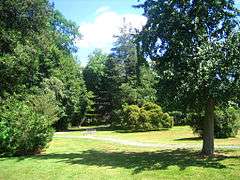 Marquand Park |
June 27, 1975 (#75001143) |
50 Lovers Ln 40°20′29″N 74°40′16″W |
1855 | The park was laid out by John Notman as a romantic landscape with many exotic plants and trees. It is named after former owner Allan Marquand whose descendants turned the property into a public park. |
| 29 | Nassau Christian Center | 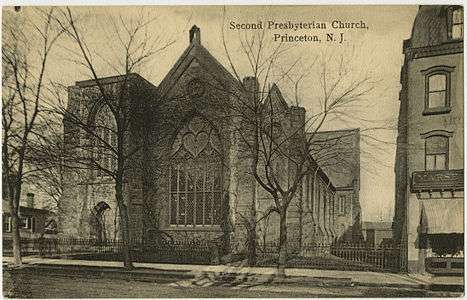 Nassau Christian Center |
June 27, 1975 (#75001143) |
26 Nassau St 40°20′57″N 74°39′44″W |
1868 | Built as Second Presbyterian Church of Princeton, the church was originally planned to have an exceedingly tall spire which was not added for cost reasons. It is now home to an Assemblies of God congregation.[12] |
| 30 | Chancellor Green Library |  Chancellor Green Library |
June 27, 1975 (#75001143) |
95 Nassau St 40°20′57″N 74°39′31″W |
1870 | A Venetian Gothic structure designed by William Appleton Potter as the first standalone library of Princeton University. It is noted for its multi-colored tile roof, detailed stone work, stained glass windows, and striking interior. |
| 31 | Trinity Episcopal Church | .jpg) Trinity Episcopal Church |
June 27, 1975 (#75001143) |
33 Mercer St 40°20′50″N 74°39′53″W |
1870 | An historic Episcopalian congregation. The original 1833 Greek Revival building by Charles Steadman was replaced in 1870 by this Gothic design by Richard Upjohn. A major reconstruction was undertaken by Ralph Adams Cram in 1914. |
| 32 | Stuart Hall | .jpg) Stuart Hall |
June 27, 1975 (#75001143) |
45 Alexander 40°20′43″N 74°39′47″W |
1876 | The main classroom building of the Princeton Theological Seminary, designed by William Appleton Potter in Venetian Gothic style. |
| 33 | Murray-Dodge Hall | 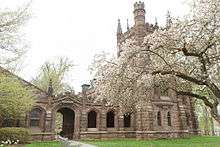 Murray-Dodge Hall |
June 27, 1975 (#75001143) |
McCosh Walk 40°20′53″N 74°39′28″W |
1879 | Built for the Princeton University Evangelical Philadelphian Society in 1879 (Murray Hall) and 1900 (Dodge Hall) by Richard Morris Hunt. Murray Hall, known as Theater Intime, is now a theater and Dodge Hall, commonly called Murray-Dodge, is home to the Office of Religious Life. |
| 34 | 32 Wiggins Street |  32 Wiggins Street |
June 27, 1975 (#75001143) |
32 Wiggins 40°21′11″N 74°39′31″W |
c. 1880 | A fine example of "carpenters" Queen Anne architecture with lapped shingles and a hexagonal tower. It is typical of the spacious Victorian houses in the neighborhood. |
| 35 | William Berryman Scott House | 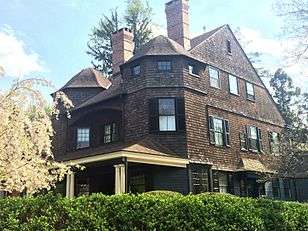 William Berryman Scott House |
June 27, 1975 (#75001143) |
56 Bayard Ln 40°21′03″N 74°39′59″W |
1888 | Designed by A. Page Brown for William Berryman Scott, it is an interesting example of Shingle style architecture with ample proportions and skillful use of material.[13] |
| 36 | Alexander Hall (Princeton University | Alexander Hall (Princeton University |
June 27, 1975 (#75001143) |
68 Nassau St 40°20′54″N 74°39′38″W |
1892 | A Richardsonian Romanesque concert hall designed by William Appleton Potter. The massive stone walls are punctuated by arches, with turrets at the four corners. |
| 37 | Tiger Inn | Tiger Inn |
June 27, 1975 (#75001143) |
48 Prospect Ave 40°20′56″N 74°39′08″W |
1895 | Third eating club at Princeton University, with reputation as the Animal House of Princeton.[14] |
| 38 | Blair Tower |  Blair Tower |
June 27, 1975 (#75001143) |
26 University Pl 40°20′51″N 74°39′39″W |
1896 | One of the early Collegiate Gothic buildings at Princeton University, designed by Cope and Stewardson to provide a monumental staircase and arch entrance from the Princeton train station (1865). |
| 39 | Lower Pyne | .jpg) Lower Pyne |
June 27, 1975 (#75001143) |
42 Nassau St 40°21′00″N 74°39′35″W |
1896 | Designed by Raleigh C. Gildersleeve for Moses Taylor Pyne in Tudor Revival style. It originally housed dormitories above commercial space as a way to integrate the Princeton University campus with the town. |
| 40 | Old Princeton Bank and Trust |  Old Princeton Bank and Trust |
June 27, 1975 (#75001143) |
12 Nassau St 40°20′56″N 74°39′47″W |
1896 | Designed by William E. Stone in Dutch Colonial style, the building demonstrates diversity of architectural styles within the architectural unity of the town. |
| 41 | Ivy Club | 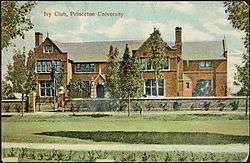 Ivy Club |
June 27, 1975 (#75001143) |
43 Prospect Ave 40°20′53″N 74°39′08″W |
1897 | Oldest and most prestigious eating club at Princeton University, first housed in Ivy Hall, from which it got its name.[15] |
| 42 | Thanet Lodge | 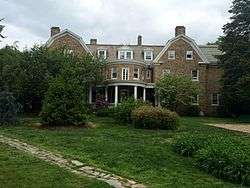 Thanet Lodge |
June 27, 1975 (#75001143) |
53 Bayard Lane 40°21′03″N 74°39′56″W |
1902 | The 1902 mansion of famed archaeologist and Olympic athlete William Libbey, now home to the Lewis School of Princeton |
| 43 | FitzRandolph Gate | 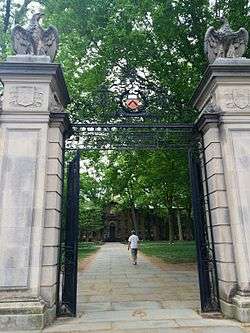 FitzRandolph Gate |
June 27, 1975 (#75001143) |
91 Nassau St 40°20′59″N 74°39′35″W |
1905 | The main gate of Princeton University, designed by McKim, Mead & White using adapted Georgian ironwork. It is named after Nathaniel FitzRandolph, who donated the land on which Nassau Hall sits. |
| 44 | Colonial Club | Colonial Club |
June 27, 1975 (#75001143) |
40 Prospect ave 40°20′56″N 74°39′10″W |
1906 | Fifth oldest eating club at Princeton University, referred to as "flamboyant Colonial" by F. Scott Fitzgerald in This Side of Paradise |
| 45 | Cap and Gown Club | Cap and Gown Club |
June 27, 1975 (#75001143) |
61 Prospect ave 40°20′54″N 74°39′04″W |
1908 | The only eating club at Princeton University to stay at the same location since its founding. The current clubhouse is the third on site.[16] Members perpetrated the Great Dinky Robbery of 1963. |
| 46 | Campus Club | Campus Club |
June 27, 1975 (#75001143) |
5 Prospect ave 40°20′51″N 74°39′16″W |
1909 | Former eating club at Princeton University closed in 2005 and turned into a student lounge |
| 47 | Palmer Physical Laboratory | 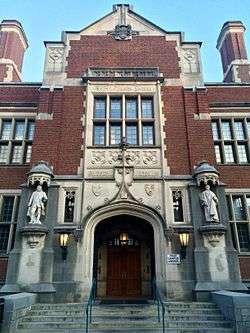 Palmer Physical Laboratory |
June 27, 1975 (#75001143) |
Princeton University 40°20′49″N 74°39′19″W |
1909 | The former Palmer Physical Laboratory, built 1910 to house the Princeton University Physics Department, home to lectures by Albert Einstein and work on the Manhattan Project, renovated and expanded in 2000 into the Frist Campus Center[17] |
| 48 | Cannon Club | 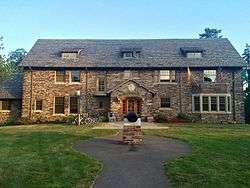 Cannon Club |
June 27, 1975 (#75001143) |
21 Prospect ave 40°20′52″N 74°39′12″W |
1910 | One of the eating clubs at Princeton University, closed in the early 1970s following racially charged incidents, reopened 2011 |
| 49 | Princeton United Methodist Church | 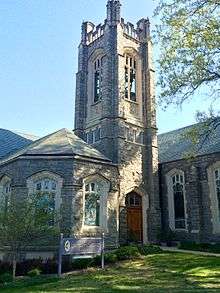 Princeton United Methodist Church |
June 27, 1975 (#75001143) |
7 Vandeventer 40°21′03″N 74°39′25″W |
1911 | Founded in 1847, the present sanctuary was dedicated in 1911 on property donated by Moses Taylor Pyne.[18] |
| 50 | Princeton University Press | 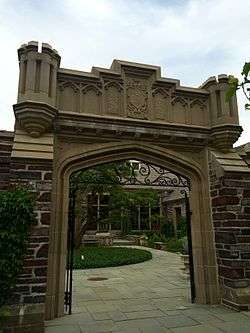 Princeton University Press |
June 27, 1975 (#75001143) |
41 William St 40°21′00″N 74°39′13″W |
1911 | Founded by Whitney Darrow, with the financial support of Charles Scribner, as a printing press to serve the Princeton community in 1905, with a distinctive building designed by Ernest Flagg[19] |
| 51 | Graduate College | 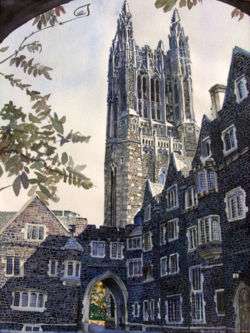 Graduate College |
June 27, 1975 (#75001143) |
1 College Rd 40°20′26″N 74°39′53″W |
1913 | Designed by Ralph Adams Cram and contains some of the most spectacular Collegiate Gothic architecture on Princeton's campus, including Cleveland Tower, Proctor Hall, and the Van Dyke Library. |
| 52 | Charter Club | 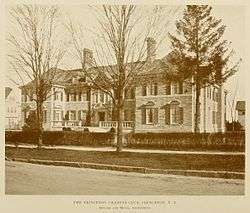 Charter Club |
June 27, 1975 (#75001143) |
79 Prospect ave 40°20′56″N 74°39′00″W |
1914 | Ninth eating club at Princeton University, party in 1988 sent 45 to the hospital[20] |
| 53 | University Dining Halls | .jpg) University Dining Halls |
June 27, 1975 (#75001143) |
Madison Hall 40°20′54″N 74°39′45″W |
1916 | Designed by Day and Klauder, a complex of five Gothic dining halls arranged around a central kitchen. The structure is named Madison Hall after alumnus James Madison. At present only two of the halls are used for dining.[21] |
| 54 | Quadrangle Club | Quadrangle Club |
June 27, 1975 (#75001143) |
33 Prospect ave 40°20′53″N 74°39′10″W |
1916 | One of the eating clubs at Princeton University, described by F. Scott Fitzgerald in This Side of Paradise as "Literary Quadrangle"[22] |
| 55 | Tower Club | 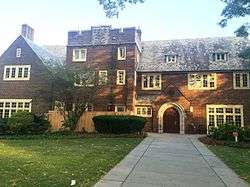 Tower Club |
June 27, 1975 (#75001143) |
13 Prospect ave 40°20′52″N 74°39′14″W |
1917 | One of the eating clubs at Princeton University, formed 1902 |
| 56 | Terrace Club | 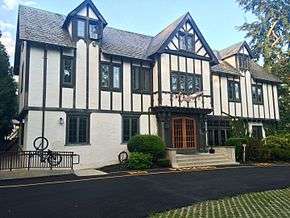 Terrace Club |
June 27, 1975 (#75001143) |
13 Prospect ave 40°20′50″N 74°39′14″W |
1920 | One of the eating clubs at Princeton University. The clubhouse was reconstructed on the former home of John Grier Hibben.[23] |
| 57 | Princeton Battle Monument | .jpg) Princeton Battle Monument |
June 27, 1975 (#75001143) |
1 Monument Dr 40°20′52″N 74°39′57″W |
1922 | The monument was designed by the prominent Beaux Arts sculptor Frederick MacMonnies with the assistance of architect Thomas Hastings. It commemorates the January 3, 1777 Battle of Princeton, and depicts General George Washington leading his troops to victory as well as the death of General Hugh Mercer. It stands 50 feet (15 m) tall and was inspired by carvings on the Arc de Triomphe in Paris. |
| 58 | McCormick Hall | McCormick Hall |
June 27, 1975 (#75001143) |
Princeton University campus 40°20′50″N 74°39′29″W |
1923 | The oldest component of McCormick Hall, home to the Princeton University Art Museum, built 1923 and designed in Venetian Gothic by Ralph Adams Cram |
| 59 | Cloister Inn | 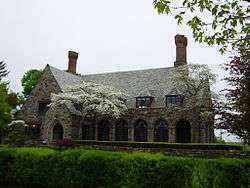 Cloister Inn |
June 27, 1975 (#75001143) |
65 Prospect ave 40°20′55″N 74°39′02″W |
1924 | The 16th eating club to be founded at Princeton University |
| 60 | Princeton University Chapel | 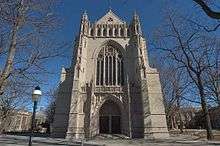 Princeton University Chapel |
June 27, 1975 (#75001143) |
Chapel Drive 40°20′56″N 74°39′25″W |
1928 | Built at a cost of $2,000,000 after the previous Marquand Chapel was destroyed by fire in 1920. Seats nearly 2,000 and was the second largest university chapel in the world when built, after that of King's College, Cambridge.[24] |
| 61 | Palmer Square Post Office | .jpg) Palmer Square Post Office |
June 27, 1975 (#75001143) |
20 Palmer Sq E 40°21′01″N 74°39′40″W |
1937 | Built during the New Deal, the post office is known for its mural, Columbia under the Palm, painted by Karl Free for the Section of Painting and Sculpture. The mural has come under criticism for its depiction of the triumph of European settlers over indigenous peoples.[25] |
| 62 | Nassau Inn |  Nassau Inn |
June 27, 1975 (#75001143) |
10 Palmer Square 40°21′02″N 74°39′40″W |
1938 | Princeton's only full service hotel, dates to 1769, current building to 1938 as part of Palmer Square, Yankee Doodle Tap Room home to Norman Rockwell mural[26] |
| 63 | Dillon Gymnasium | 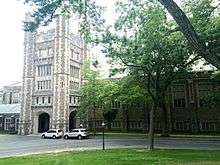 Dillon Gymnasium |
June 27, 1975 (#75001143) |
Elm Drive 40°20′44″N 74°39′32″W |
1947 | Replaced University Gymnasium, which burned to the ground in 1944. Houses a 1,500-seat gymnasium, squash courts and a pool. Designed by Aymar Embury and named for Herbert L. Dillon, class of 1907, a one-time football captain.[27] |
| 64 | Firestone Library | 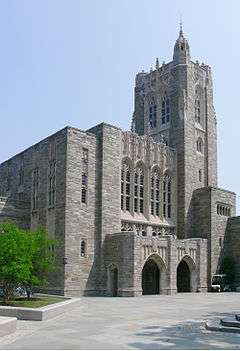 Firestone Library |
June 27, 1975 (#75001143) |
1 Washington Road 40°20′58″N 74°39′27″W |
1948 | The main library system of Princeton University, named after tire magnate Harvey Firestone, with holdings of more than 7 million books, 6 million microforms, and 48,000 linear feet of manuscripts[28] |
See also
| Wikimedia Commons has media related to Princeton Historic District (Princeton, New Jersey). |
References
- "New Jersey and National Registers of Historic Places — Mercer County" (PDF). New Jersey Department of Environmental Protection — Historic Preservation Office. April 5, 2013. p. 8. Archived from the original (PDF) on May 16, 2013. Retrieved June 4, 2013.
- "Princeton Historic District". National Register of Historic Places. National Park Service.
- Numbers represent an ordering by significant words. Various colorings, defined here, differentiate National Historic Landmarks and historic districts from other NRHP buildings, structures, sites or objects.
- The eight-digit number below each date is the number assigned to each location in the National Register Information System database, which can be viewed by clicking the number.
- Hageman, John Frelinghuysen (1878). History of Princeton and Its Institutions, Volume 1. Philadelphia: J.B. Lippincott & Company. p. 65.
barracks.
- Hageman, John Frelinghuysen (1879). History of Princeton and Its Institutions, Volume 1. J.B. Lippincott & Company. p. 96.
Jonathan deare University Hotel.
- Levin, Eric (July 15, 2014). "The 25 Best Restaurants of 2014". New Jersey Monthly.
- "Princeton's Historic Sites and People". Historical Society of Princeton.
- Hageman, John Frelinghuysen (1878). History of Princeton and Its Institutions, Volume 1. Philadelphia: J.B. Lippincott & Company. p. 123.
Samuel Miller home.
- Leitch, Alexander (1978). A Princeton Companion. Princeton University Press.
- "Springdale". Historical Society of Princeton.
- Hageman, John Frelinghuysen (1879). History of Princeton and Its Institutions, Volume 2. J.B. Lippincott & Company. pp. 200–208.
- "Two Houses are in Focus". Town Topics. October 4, 1978.
- Rojas, Cristina. "Leaders of Tiger Inn, a Princeton eating club, resign after party". Times of Trenton.
- Yazigi, Monique (May 16, 1999). "At Ivy Club, A Trip Back to Elitism". New York Times. Retrieved February 2, 2011.
- "Cap & Gown Club". Princeton University.
- "Campus Center Iconography". Frist Campus Center. Princeton University.
- "Church History". Princeton United Methodist Church.
- Letich, Alexander (1978). A Princeton Companion. Princeton University Press. Archived from the original on 2017-10-19. Retrieved 2015-07-16.
- Bloom, Craig (February 12, 1989). "Clubs at Princeton Curb Drinking". New York Times.
- Leitch, Alexander. "Madison Hall". Princeton University.
- Tumball, Andrew. Scott Fitzgerald. New York: Grove Press, 2001: p. 57
- "Terrace Club". Princeton University.
- "History of the Chapel". Office of Religious Life. Princeton University.
- "Palmer Square Post Office Mural". The Living New Deal.
- "Our History". Nassau Inn.
- Leitch, Alexander (1978). A Princeton Companion. Princeton University Press. p. 137.
- "Princeton University Library". Princeton University.